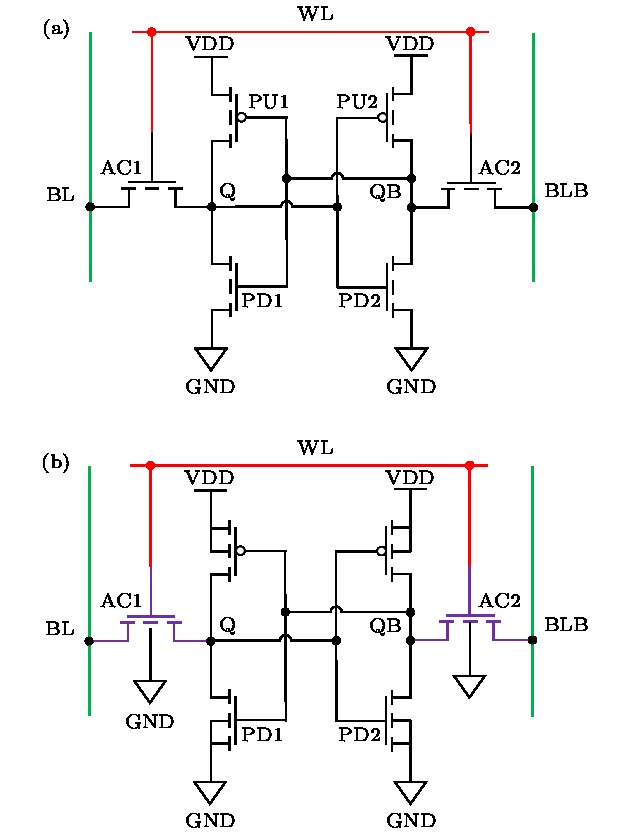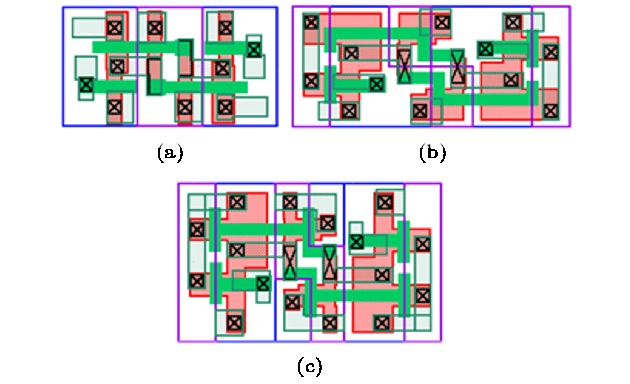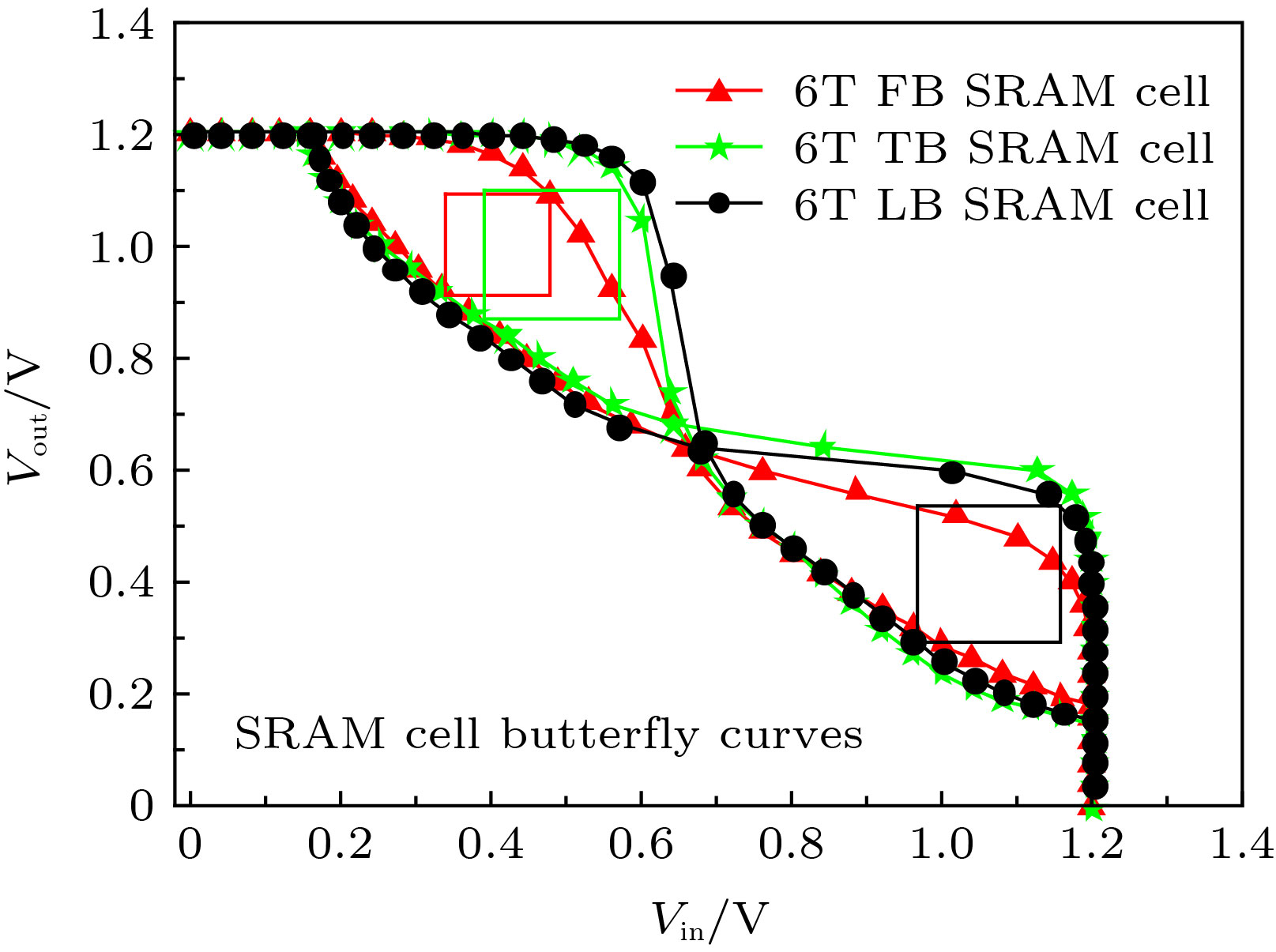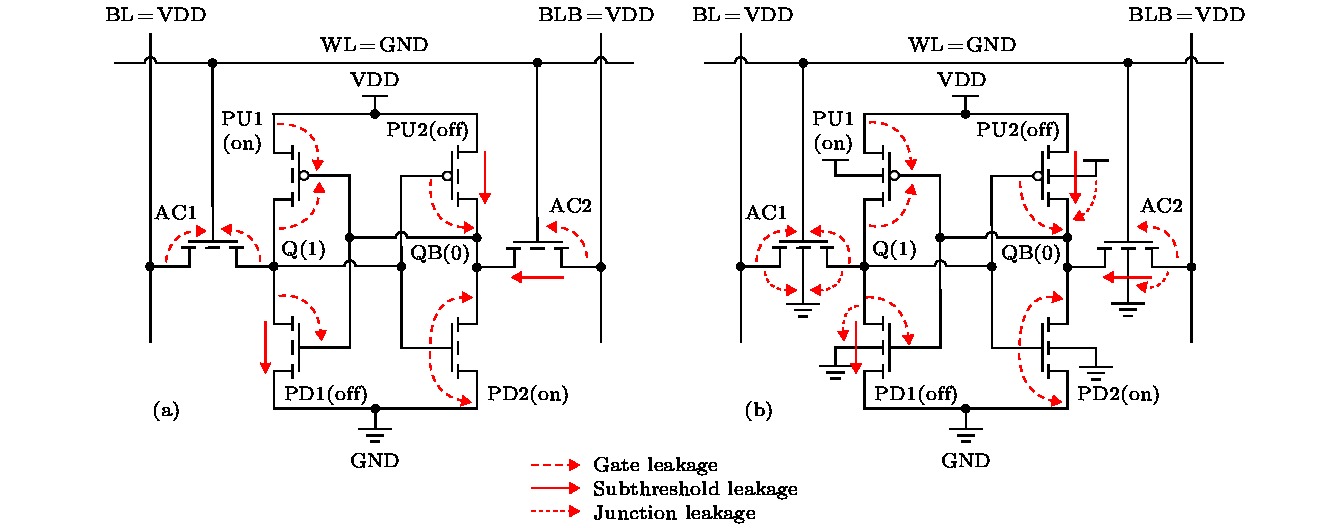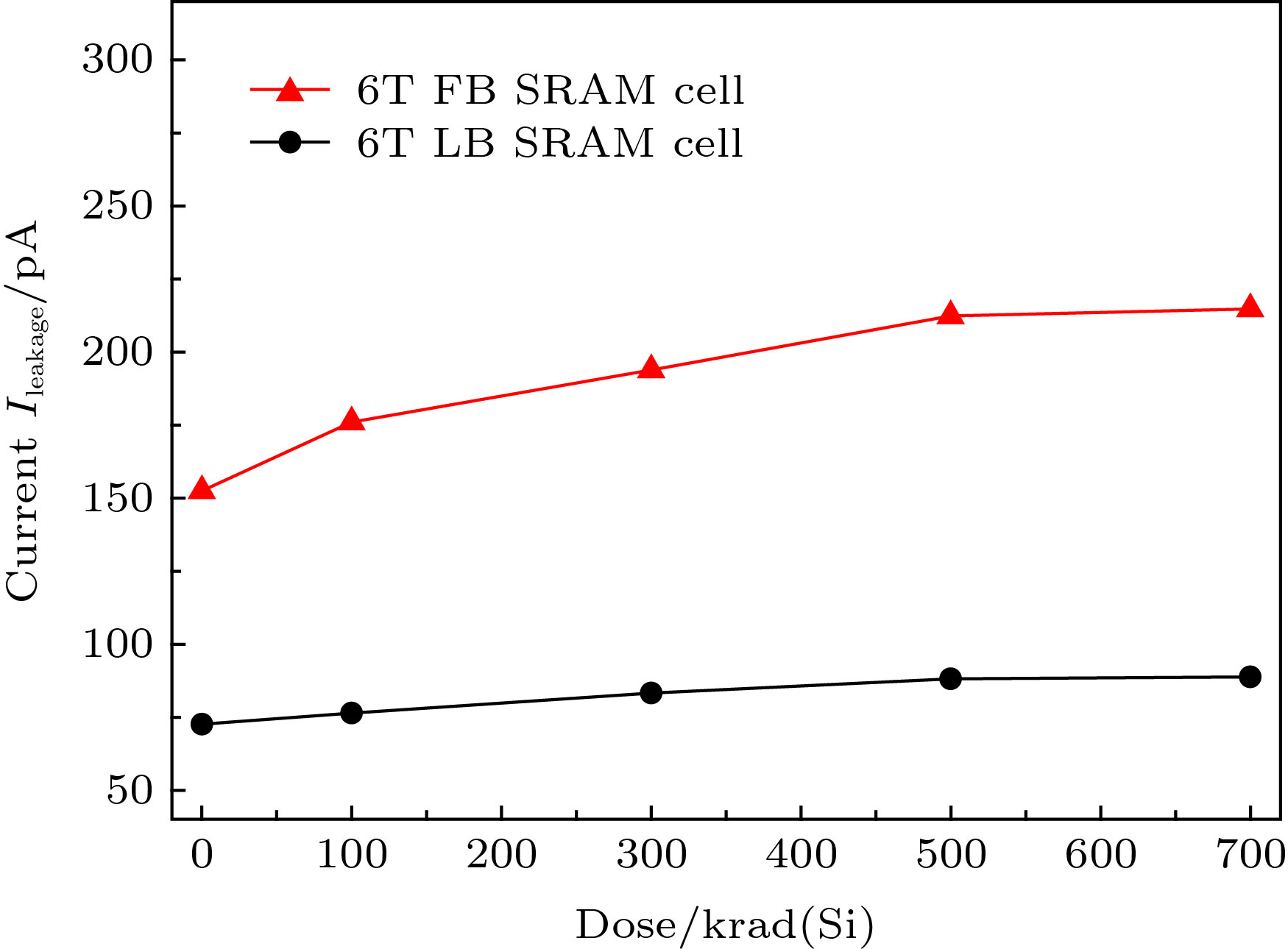-
静态随机存储器作为现代数字电路系统中常见且重要的高速存储模块, 对于提升电子系统性能具有重要作用. 到目前为止, 关于静态随机存储器单元总剂量辐射效应的数据依然有待补充完善. 本文采用130 nm绝缘体上硅工艺, 设计制备了一种基于L型栅体接触场效应晶体管器件的6晶体管静态随机存储器单元. 该L型栅体接触器件遵循静态随机存储器单元中心对称的版图特点, 使得存储单元面积相比于采用同器件尺寸的T型栅体接触器件的静态随机存储器单元减小约22%. 文中对比研究了L型栅体接触器件与其他场效应晶体管之间的电学性能差异, 以及基于不同场效应晶体管静态随机存储器单元的漏电流和读状态下静态噪声容限随辐射总剂量增加的变化规律. 测试结果表明, L型栅体接触器件与T型栅体接触器件的器件性能接近, 但前者具有面积更小的优势; 同时基于L型栅体接触场效应晶体管的静态随机存储器单元的基本电学性能以及抗总剂量辐射效应均优于传统基于浮体场效应晶体管的静态随机存储器单元, 因而具有稳定可靠的实用价值.The static random access memory (SRAM), as a common and important high-speed storage module in modern digital circuit systems, plays an important role in improving the performances of electronic systems. The data about the total ionizing dose (TID) radiation effect of SRAM cell have not been rich in the literature so far. In this work, a novel 6-transistor SRAM cell (6T LB SRAM cell) based on L-type gate body-contact (LB) MOSFET device is designed and fabricated by 130nm silicon-on-insulator (SOI) process. The LB MOSFET follows the center-symmetric layout design of the SRAM cell, reducing the area by approximately 22% compared with the SRAM cell using the T-type gate MOSFET contact device (6T TB SRAM cell) of the same device size. The electrical performance difference between LB MOSFET and other devices is compared. Besides this, the variations of the leakage current and the reading static noise margin (RSNM) of SRAM cells based on different MOSFETs under various total ionizing doses are also investigated. The test results indicate that the LB MOS successfully suppresses the floating body effect (FBE), and that the drain-induced barrier lowing (DIBL) and drain-to-source breakdown voltage (BVds) characteristics are improved. The performance of this device is similar to that of TB MOS device, but due to the special body contact design, the former has an advantage of smaller area. Due to the use of the body contact device, the leakage current of the 6T LB SRAM cell is significantly smaller than that of the conventional floating device SRAM cell (6T FB SRAM cell), which has lower static power consumption. After 60Co-γ ray irradiation, the 700 krad(Si) radiation dose only increases the leakage current of 6T LB SRAM cell by 21.9%, which is better than 41.4% of 6T FB SRAM cell. In addition, the 6T LB SRAM cell has an RSNM value similar to that of the 6T TB SRAM cell, and this is 1.93 times higher than the that of 6T FB SRAM cell. The radiation experiment causes the butterfly curve of the 6T FB SRAM cell to be asymmetrically deformed, and the stability of the SRAM cell is deteriorated due to the TID effect. However, the test results show that when the radiation dose reaches 700 krad (Si), the RSNM value of the 6T LB SRAM cell is reduced only by 11.2%. Therefore, 6T LB SRAM cell has stable and reliable practical value.
-
Keywords:
- static random access memory cell /
- total ionizing dose effects /
- silicon-on-insulator /
- body-contact
[1] Schwank J R, Cavrois F, Shaneyfelt M R, Paillet P, Dodd P E 2003 IEEE Trans. Nucl. Sci. 50 522
 Google Scholar
Google Scholar
[2] Verma S, Abdullah M 2015 Int. J. Computer Appl. 130 17
[3] Barnaby H J 2006 IEEE Trans. Nucl. Sci. 53 3103
 Google Scholar
Google Scholar
[4] Yao X Y, Hindman N, Clark L T, Holbert K E, Alexander D R, Shedd W M 2008 IEEE Trans. Nucl. Sci. 55 3280
 Google Scholar
Google Scholar
[5] Annamalai N K, Biwer M C 1988 IEEE Trans. Nucl. Sci. 35 1372
 Google Scholar
Google Scholar
[6] Colinge J P, Terao A 1993 IEEE Trans. Nucl. Sci. 40 78
 Google Scholar
Google Scholar
[7] Schwank J R, Shaneyfelt M R, Draper B L, Dodd P E 1999 IEEE Trans. Nucl. Sci. 46 1809
 Google Scholar
Google Scholar
[8] Parke S, DeGregorio K, Goldston M, Hayhurst R, Hackler D 2005 IEEE Aerospace Conference
[9] Mercha A, Rafi J M, Simoen E, Augendre E, Claeys C 2003 IEEE Trans. Electron Devices 50 1675
 Google Scholar
Google Scholar
[10] Chaudhry A, Kumar M J 2004 IEEE Trans. Device Mater. Reliab. 4 99
 Google Scholar
Google Scholar
[11] Kaifi M, Siddiqui M J 2011 International Conference on Multimedia, Signal Processing and Communication Technologies, Aligarh, Uttar Pradesh, India December17—19, 2011 p216
[12] Maeda S, Hirano Y, Yamaguchi Y, Iwamatsu T, Ipposhi T, Ueda K, Mashiko K, Maegawa S, Abe H, Nishimura T 1999 IEEE Trans. Electron Devices 46 151
 Google Scholar
Google Scholar
[13] Singh J, Mohanty S P, Pradhan D K 2013 Robust SRAM Designs and Analysis (New York: Springer Science+Business Media) pp31—56
[14] He W W, Chen J, Luo J X, Chai Z, Wang X 2016 Electron. Lett. 52 1172
 Google Scholar
Google Scholar
[15] Arora 1993 MOSFET Models for VLSI Circuit Simulation: Theory and Practice (Berlin: Springer) pp210—219
[16] Ning B X, Zhang Z X 2013 International Journal of Electronics and Electrical Engineering 1 31
 Google Scholar
Google Scholar
[17] Youk G U, Khare P S, Schrimpf R D, Massengill L W, Galloway K F 1999 IEEE Trans. Nucl. Sci. 46 1830
 Google Scholar
Google Scholar
[18] Peng C, Zhang Z X, Hu Z Y, Huang H X, Ning B X, Bi D W 2013 Chin. Phys. Lett. 30 098502
 Google Scholar
Google Scholar
[19] Seevinck E, List F J, Lohstroh J 1987 IEEE J. Solid-State Circuits 22 748
 Google Scholar
Google Scholar
[20] 宁冰旭 2013 博士学位论文(上海: 中国科学院上海微系统与信息技术研究所)
Ning B X 2013 Ph. D. Dissertation (Shanghai: Shanghai Institute of Microsystem and Information Technology March) (in Chinese)
[21] Re V, Manghisoni M, Ratti L, Speziali V, Traversi G 2005 IEEE Radiat. Eff. Data Workshop 122
[22] Uyemura J P 2002 Introduction to VLSI Circuits and Systems (Hoboken: Wiley) pp237—244
-
图 1 (a) FB NMOS版图; (b) TB NMOS版图; (c) LB NMOS 3维示意图; (d) LB PMOS版图; (e) LB NMOS版图; (f) LB NMOS器件沿(e)图线A-A'截取的器件横截面图
Fig. 1. (a) The layout of FB SOI nMOSFET; (b) the layout of TB SOI nMOSFET; (c) the LB nMOSFET 3-dimensional schematic; (d) the layout of LB pMOSFET; (e) the layout of LB nMOSFET; (f) a cross-sectional view of LB nMOSFET is taken along line A-A' in (e).
表 1 基于LB和FB MOS器件静态随机存储器单元在辐照过程中的偏置条件
Table 1. Bias conditions of 6T LB cell and 6T FB cell during irradiation.
测试项 VDD GND SUB WL BL BLB Q QB 漏电流(Ileakage)/V 1.32 0 0 0 1.32 1.32 读取静态噪声容限(RSNM)/V 1.32 0 0 1.32 1.32 1.32 0 1.32 -
[1] Schwank J R, Cavrois F, Shaneyfelt M R, Paillet P, Dodd P E 2003 IEEE Trans. Nucl. Sci. 50 522
 Google Scholar
Google Scholar
[2] Verma S, Abdullah M 2015 Int. J. Computer Appl. 130 17
[3] Barnaby H J 2006 IEEE Trans. Nucl. Sci. 53 3103
 Google Scholar
Google Scholar
[4] Yao X Y, Hindman N, Clark L T, Holbert K E, Alexander D R, Shedd W M 2008 IEEE Trans. Nucl. Sci. 55 3280
 Google Scholar
Google Scholar
[5] Annamalai N K, Biwer M C 1988 IEEE Trans. Nucl. Sci. 35 1372
 Google Scholar
Google Scholar
[6] Colinge J P, Terao A 1993 IEEE Trans. Nucl. Sci. 40 78
 Google Scholar
Google Scholar
[7] Schwank J R, Shaneyfelt M R, Draper B L, Dodd P E 1999 IEEE Trans. Nucl. Sci. 46 1809
 Google Scholar
Google Scholar
[8] Parke S, DeGregorio K, Goldston M, Hayhurst R, Hackler D 2005 IEEE Aerospace Conference
[9] Mercha A, Rafi J M, Simoen E, Augendre E, Claeys C 2003 IEEE Trans. Electron Devices 50 1675
 Google Scholar
Google Scholar
[10] Chaudhry A, Kumar M J 2004 IEEE Trans. Device Mater. Reliab. 4 99
 Google Scholar
Google Scholar
[11] Kaifi M, Siddiqui M J 2011 International Conference on Multimedia, Signal Processing and Communication Technologies, Aligarh, Uttar Pradesh, India December17—19, 2011 p216
[12] Maeda S, Hirano Y, Yamaguchi Y, Iwamatsu T, Ipposhi T, Ueda K, Mashiko K, Maegawa S, Abe H, Nishimura T 1999 IEEE Trans. Electron Devices 46 151
 Google Scholar
Google Scholar
[13] Singh J, Mohanty S P, Pradhan D K 2013 Robust SRAM Designs and Analysis (New York: Springer Science+Business Media) pp31—56
[14] He W W, Chen J, Luo J X, Chai Z, Wang X 2016 Electron. Lett. 52 1172
 Google Scholar
Google Scholar
[15] Arora 1993 MOSFET Models for VLSI Circuit Simulation: Theory and Practice (Berlin: Springer) pp210—219
[16] Ning B X, Zhang Z X 2013 International Journal of Electronics and Electrical Engineering 1 31
 Google Scholar
Google Scholar
[17] Youk G U, Khare P S, Schrimpf R D, Massengill L W, Galloway K F 1999 IEEE Trans. Nucl. Sci. 46 1830
 Google Scholar
Google Scholar
[18] Peng C, Zhang Z X, Hu Z Y, Huang H X, Ning B X, Bi D W 2013 Chin. Phys. Lett. 30 098502
 Google Scholar
Google Scholar
[19] Seevinck E, List F J, Lohstroh J 1987 IEEE J. Solid-State Circuits 22 748
 Google Scholar
Google Scholar
[20] 宁冰旭 2013 博士学位论文(上海: 中国科学院上海微系统与信息技术研究所)
Ning B X 2013 Ph. D. Dissertation (Shanghai: Shanghai Institute of Microsystem and Information Technology March) (in Chinese)
[21] Re V, Manghisoni M, Ratti L, Speziali V, Traversi G 2005 IEEE Radiat. Eff. Data Workshop 122
[22] Uyemura J P 2002 Introduction to VLSI Circuits and Systems (Hoboken: Wiley) pp237—244
计量
- 文章访问数: 14101
- PDF下载量: 82
- 被引次数: 0














 下载:
下载:

